We ride on elevated rails and freeways, pass through subterranean tubes, moving quickly from apartment to office, home entertainment center to computer work station, from couch to seat. We sit before glowing screens, transporting data and occasionally rise to get some water, or perhaps a cigarette, relieving ourselves of the sedentary strain of our working lives. We notice the ache in our shoulders, the stiffness in our necks, that we have gained a few pounds, and feel one of our “normal” headaches coming on. “Must get back to the gym,” we tell ourselves. “It’s been a few weeks.”
Chained to our desks, we busy ourselves, check our email for the tenth time that morning, then click to Facebook. Just want to look in on our “friends”. “What are people thinking right now?” Our home page tells us who is finishing lunch in New York, or wishing the weekend was already here in San Francisco or what state someone thinks they are most like. Perhaps the person is like Florida, warm and sunny, but sometimes subject to tropical storms. We might find this interesting, or absurd, wondering why someone is saying this and why we are reading it. Our own virtual reality shows, each one of us viewer and participant.
Then finally, after eight or ten, maybe twelve hours, our tasks done, we are free to leave, to go “work out”, perhaps take in a movie or a restaurant, then go home to sit in front of yet another screen until it is time to sleep. Aided by the latest formulation of ambien or a few glasses of wine, we fall into some sort of sleep, awaken a few hours later, and begin again.
Our species, homo sapien, has been on this planet for two hundred thousand years, having slowly evolved from four legged creatures, migrating from the trees to the ground to become upright hominids with brains expanding, making room for reason. From the savannahs of Africa we spread, gathering wild fruits, scratching out grubs and roots first with our hands, and then with rough tools, technological extensions of our natural senses. We built weapons to hunt wild animals which we then cooked in the fire which we had discovered and moved in small bands from place to place, following our food, sedentary as long as we could eat and remain safe from the predators hidden in the darkened landscapes beyond our huddled encampments. What lay behind the forces to which we were exposed was unknown—the rains, change of seasons, earthquakes, birth, death, menstruation, all mysteries that infused our experience. But as our brains grew and our thoughts sharpened, we sought and found explanations. We found the Gods. Great beings, outsized projections of ourselves, who controlled the cosmos as we controlled our own small worlds, who had to be appeased, bribed, or tricked, their god power harnessed in elaborate rituals of nomadic deal making.
And co-emergent, bubbling deep within us, was an urge to become one with the “great cosmos”, a drive to merge, to transcend the narrow boundaries of self. We understood that it was at the edge of self awareness where we were separated from our deepest being, that place where one could meet the gods, dance with them, commingle. And we also realized the limits of reason. We saw that the portal to this transcendent world was opened with modalities of consciousness raising, with art and with magical foods. So we drummed, pounded on rocks and logs with hands and sticks. We painted cave walls and ate plants that altered our perception. We sang to the earth and sky, to the planets creatures, to all that we thought there was, perfectly adapted in body, mind, and spirit to move through and be of this primordial wilderness.
Then came agriculture. We learned that seeds left in the ground sprouted plants that could be eaten, dried, and stored. Small tribes no longer had to wander from place to place in search of food. It was the beginning of sedentary culture, of specialization, of the emergence of a class of rulers who controlled the stores of food, priests who appealed to the gods for growth and fertility, workers who plowed the fields and hauled the grain, and those who built the storehouses, the city walls, and the temples. From the Pyramids of Egypt to the Gardens of Babylon, from the Great Wall of China to the Jaguar Temples of the Maya, monuments were built to the gods, cosmic reflections of the men who built them, anthropomorphic glorification of an emergent Promethius. From here, it was a straight line through the Greek and Roman Empires, a monotheistic congealing of the gods, and an industrially revolutionized world creating empires built upon mass production and increased specialization, with men and women ever more tightly bound to place, to assembly line rote, prisoners of the clock, crushed by the mechanization of not only space but time, human experience broken into ever reduced units of production.
Now we have arrived in the post-industrial world of late American Empire. In our partitioned cubicles, we trudge, pecking away at our keyboards, invisibly shackled. The sedentary life begun on the banks of the Tigris and Euphrates rivers has reached its logical conclusion. Immobile, we stare. Worlds open up on the other side of the neon screen, yet we, the programmers, the “creators” are enslaved, dependent upon that which we have created.
So who and what are we? Mechanically identical to our hunting and gathering ancestors who walked the great savannahs and followed the herds seeking a survival rooted harmony with the natural world, we now wander great malls, through forests of consumption. Our physical strength derives not from running through the woods, chasing animals, but from running on treadmills, going faster and faster, getting nowhere. We lift weights, balance on balls, grunting under heavy metal stacks, with the world of nature nowhere in sight. Our food is pre-packaged, vegetables genetically modified (although we never really know how much since THEY don’t have to tell us), our work not building, lifting, or moving, but instead sitting, sitting, sitting, with momentary breaks to ease the crush of bland stillness.
We need to acknowledge and re-connect to that which gave birth to us, to accept who and what we are, and are not. We cannot dismantle the post industrial world, cannot recreate some romantic pastoral vision, where men and women lived in jubilant harmony with nature. Nor would we want to. Because there really was no such romance, no such world. Life was harsh and brutal, with deaths threat ever present. But our bodies and minds had adapted, our brains wired so the flesh could live, perfect mechanisms moving in rhythmic counterpoint to the melodies and harmonies of the jungle while also keenly sensing the ineffable, the mysteries behind the veil of material struggle. Post and pre-modern man, hunters and gatherers, agriculturalists, industrial and neo-industrial cogs–all cultural labels, mental constructions superimposed upon biological realities. We are more than homo economicus. We are the “great sapien”, beings able to experience life deeply–pain, love, sexual desire, fear, transcendence, joy, anger, and compassion.
Sickness and disease are born in resistance to life. Whether seething at a desk doing meaningless work, being compelled to say things that are untrue, or simply bending over papers for hours at a time, the tension in our bodies build. In our primordial past, when one was attacked, that person would mobilize their energy, prepare to fight or run, and then discharge the hormonal intensity when the threat has gone. But now, the threat does not pass. It hovers, ever present, sometimes excruciating in its subtlety, throughout the day and even with us at night, sometimes haunting our dreams. Our bodies cringe, tightening, constricting blood flow and lymphatic drainage. We lose our breath, become anxious, our brains deprived of precious oxygen. Our state is constantly weakened. We become sick, or sicker.
Then how do we heal? Healing is in the living, in the being at this very moment, hearts and lungs open, moving to the planetary and cosmic rhythms, finding some joy in the now. Our immune systems respond directly to messages sent from our brains, signals that release healing chemicals that have evolved over millions of years for just this task. To the extent that we can relax, physically move our bodies, laugh and love, even under the terrible conditions of serious illness, we can stimulate the programmed magnificence of our bodies. Healing is a physical, chemical, emotional, and spiritual affair, every level engaged. And yes, there are times when nothing can be done to reverse a sickness–a terrible genetic disease, an overwhelming viral assault, a devastating accident. And it is not our fault. And we may die. And there are times when only powerful drugs will sustain us, necessary to support the irreparable wreckage of our bodies. But even in the awful face of our extinction, there can be healing, for to heal does not only mean to survive. To heal is also to find ones purpose and meaning and open ones life to the radiant love that pervades our universe, to do so in each moment without fear. It is to dive into that ineffable well of mystery. And in this way, even in death, it is possible to be healed.
Built into our contemporary biological structures are the very same patterns that have enabled us to live and to thrive throughout human history. We were perfectly designed to walk several miles each day, to throw spears, to chase, to sit around a fire at the end of the day, eating, picking our teeth, maybe drumming or singing some tribal songs, having sex, sleeping, and waking to do it all again. Lives relatively short, but intense, deeply lived. Today, the miracles of modern science have certainly extended our chronological lives. We can easily live to eighty or ninety years. But what is that living? Driven by fear of scarcity on a planet exploding with billions of people, we are terrified of rest. Today most of us have fewer hours, less time for restoration than when we wandered the ancient plains. We must remain connected to the past if we wish to fully integrate our experience in the future–moving our bodies, eating wholesome foods, spending time in nature, dancing and singing, breaking out of our insulated office buildings and breathing deeply. Only through a full embrace of who we are and have been can evolutionary healing truly begin.
[email protected] www.rickyfishman.com












Hi Ricky – another thought provoking piece. Thanks for sharing! You are right, we all need to connect to the now, rejoice in what we have, not despair over what we do not. Great advice and timely piece.
Lyn B Australia
Bravo Ricky! Keep the blogs coming. I thought this was a fascinating reflection on the dualities of life in our contemporary whirl. I particularly liked the line about diving into the ineffable well of mystery that healing is and also
“opening to the radiant love that pervades our universe” and your encouragement to do so in each moment without fear. For really this moment is all there is and all we have…the here and now.
Also, did Ricky Fishman actually use the word “spiritual”???
uh, wow.
Health is participation in your life and taking care of the machine that carries you around. Another thoughtful piece, Ricky. Thanx.
Paul
And daydreaming, can’t forget to daydream! Nice writing, Ricky, and a wonderful reminder to not only embrace the beauty around us, but to continue to expand one’s world instead of contracting into fear. Learn something new, take a little risk, make mistakes!
Love you,
Claud
Very toughtful and right on the mark. Your reflections mirror my own. I have been complaining the past year about being tied to a screen and how the world has evolved to create such an unhealthy environment many of us work in. Nature continues to be the element that heals my soul (and body, and mind). Now to discipline myself and get moving! Thanks for the inspiration.
Amen Ricky! Beautiful piece.